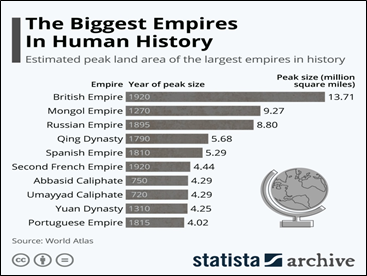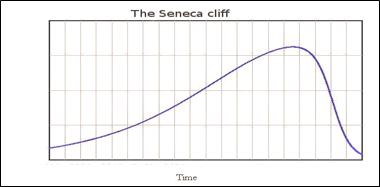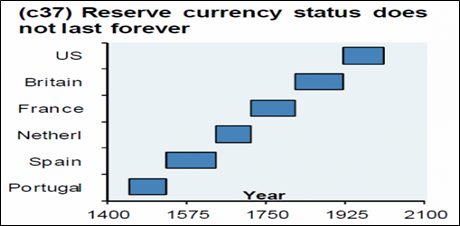What if, Part 1
This article is the first of the series covering the Author’s understanding of the outlook of great powers relations in the next ten years period. The approach is based on certain scenarios, which in turn are based on confirmed or estimated trajectories in the real world.
Before presenting the actual scenarios for the future, it may be useful to consider the theoretical framework and some relevant tools and concepts, which I have used for constructing scenarios.
Historical perspective
In the history of the humankind, empires have been built through the creation or acquisition of wealth.
The Roman Empire came about through the productivity of its people and its subsequent acquisition of wealth from those regions that it invaded. The Spanish Empire began with productivity and expanded through the use of its large armada of naval force, looting the gold worldwide.
The British Empire began through localized productivity, industrial revolution and grew through its creation of colonies worldwide – colonies that it exploited, bringing the wealth back to England to make it the wealthiest country in the world. In the Victorian Age, the Brits could say “The sun never sets on my flag.”
Even the Soviet Union with the “eternal” communism faced the final destiny after seventy years of iron ruling.

Now coming to the present empire, the United States of America, the issue of the destiny does not deviate from those historical examples mentioned above. The overall historical continuum of empires and the basic conformities to law, dictate the demise of the US as well.
Fatal issue of empire/unipole collapse
“If something cannot go on forever, it will stop”
Stein’s Law
Great powers are the key players both in the theoretical context and in the reality of international relations. Therefore, the destinies of empires / unipoles are so important to follow up and examine in details.
Two classical documents on the subject “collapsing of great power” (Paul Kennedy: The Rise and Fall of the Great Powers, 1989 and Joseph Tainter: The Collapse of Complex Societies, 1988), among others, form a theoretical base and comparable “benchmark” in assessing the prevailing situation.
Kennedy’s book focuses on national and international powers in the post-Renaissance period.
The main content and key findings are:
- Focus on major wars, changes in global economic balances and in the interaction between economies and strategies of leading states in the international system
- The military conflict is always examined in the context of economic change
- The relative strengths of the leading nations in world affairs never remain constant
- Wealth is needed to underpin military power and military power is usually needed to acquire and protect wealth
- If the over-proportion of the state’s resources is diverted from wealth creation and allocated instead to military purposes it may lead to a weakening national power (e.g. waging of very costly wars)
- The dynamics of technological change and economic growth as well as national incentives for their promotion and utilization have always created uneven growth rates among states and therefore made the international system unstable and complex
- Wealth and power are always relative and should be seen as such
- In the competitive international framework, a great power may spend much more on defense than before and yet still discover that the world around is less secure environment, simply because other powers have grown faster or utilized more technical innovations and therefore are becoming stronger
- The continual change and the differentiated pace of economic growth among the great powers, ensure they will go on rising and falling, relative to each other
Joseph Tainter’s book focuses on the ancient Roman empire and its decline and fall taking also comparable examples of numerous other falls of empires in the history of mankind.
The main content and key findings are:
- His observation is that “what happened to the ancient empires could happen in modern times.” There was much more in the Roman collapse than a simple military problem, the Roman time is like a foggy mirror of our time. History does not necessarily repeat itself but when facing similar challenges, people of all ages will tend to react in the same way
- His main points are related to the concept of “complexity of a society” and “declining marginal returns to complexity”
- By the term complexity, he obviously means all the economic, social bureaucratic and military structures that create societies; complexity is the characteristics what is usually called as “civilization”; complexity and required resources are in a feedback relationship with each other
- Resources allow the creation of more complex societal structures and these structures help exploiting resources faster and more efficiently
- The collapse can be defined as “a rapid reduction of complexity in a society”, possibly caused by resource depletion; it can be also stated that “the collapse is related to the diminishing returns of progressively increasing complexity”
- There is a strong relationship between resources and complexity, which cannot exist without plenty of resources but resource depletion can be counteracted by increasing complexity but only up to a certain point and with ever-reducing returns
- At some moment, returns become negative, society cannot support any longer its complex infrastructures and the result is collapse
No nation can produce less in the real economy and endlessly squander more on greedy finance elites, funding all that by issuing trillions of new dollars (out of thin air) and imagining that this asymmetry will never have consequences. Historian Michael Grant identified profound political disunity in the ruling class as a key cause of the dissolution of the Roman Empire. Grant described this dynamic in his excellent book “The Fall of the Roman Empire” (Barnes&Noble, 2005).
Some recent researches have forecasted the decline of unipolarity taking place soon. Robert Pape in his article “Empire Falls” (2009) argues that “the US is in unprecedented decline and it means the unipolar world is coming to an end. His argument is based on the lower rate of US economic growth vis-à-vis potential competitors like China and excessively aggressive US grand strategy of offensive dominance – applied e.g. in the Middle East and Afghanistan.
Along similar lines, Christopher Layne (2012) argues that unipolar moment is over and the era of American ascendancy in international politics is fast winding down. He explains that there are two drivers of American decline, one external and one domestic:
- External driver is the emergence of new great powers in world politics (China, Russia) and the shift of economic power from the Euro-Atlantic area to Asia, where China’s rise signals unipolarity’s end
- Domestic driver shows decline in America’s economic power, the looming fiscal crisis, getting into huge sovereign debt and increasing doubts about the dollar’s long-term hold on reserve currency status
Characteristics of failing empires
When regarding the reality of any failing empire, the story is the surprisingly same every time: some nation, due to a confluence of lucky circumstances, becomes much more powerful than the rest and, for a time, is dominant. But the lucky circumstances, in due course come to an end. In the meantime, the empire becomes corrupted by its own power. As the endgame approaches, those still nominally in charge of the collapsing empire resort to all sorts of desperate measures — all except one: they will refuse to ever consider the fact that their imperial superpower is at an end and that they should change their ways accordingly.
The approaching imperial collapse can be seen in the ever-worsening results the empire gets for its imperial efforts.
After World War II, the US was able to do a respectable job helping to rebuild Germany, along with the rest of Western Europe as well as Japan and South Korea. With Vietnam, Laos and Cambodia, all of which were badly damaged by the US military operations, the results were significantly worse. Results have been deteriorating in the first Gulf War, Iraq, Somalia, Libya, Syria, Yemen not to mention the recent full debacle in Afghanistan. So, the trend is unmistakable: whereas at its height the empire destroyed in order to rebuild the world in its own image, as it nears its end it destroys simply for the sake of destruction, leaving piles of corpses and smoldering ruins in its wake.
Another unmistakable trend has to do with the efficacy of spending money on “defense” (in the case of the US, “offense”). The well-endowed US military might sometimes lead to success but something has shifted over time, although the US military budget is nowadays nearly 50% world total. Now, more and more, military spending itself is the goal — never mind what it achieves. The latest results of weapon system development reveal the obvious success of China and Russia, while the US has wasted trillions of dollars in Afghan mountains.
The American military aid and support is also a curious thing. More often than not these weapons end up in the wrong hands: the ones they gave to Iraq were soon in the hands of ISIS; the ones they gave to the Ukrainian nationalists have been sold to the Syrian government; the ones they gave to the government in Afghanistan are now in the hands of the Taliban etc.
As empires collapse, they usually turn inward and subject their own populations to the same ill treatment to which they subjected others. Here, America is unexceptional: the growing number of Americans being murdered by other Americans and their own police is quite staggering. The unique feature in this context is the number of mass shootings, where the US is keeping firmly the world record. When pondering who their enemy really is, the Americans should look at the mirror.
Collapsism
In order to systematize and streamline the theoretical approach to the issue of “rise and fall of great powers”, a new concept or “ism” can be taken in use, collapsism.
This means:
- a way of thinking that “collapsing empires” can and will take place also in our modern time and therefore this issue can and shall be elaborated and analyzed carefully
- collapse and other discontinuities are “normal” historical events among others and they can and shall be taken under serious research
- they can be analyzed and possibly even forecast or at least take into account in plans or scenarios
- there are plenty of ways and means, tools and techniques available like historical comparisons, seeking of analogies, use of the concept Seneca Cliff, utilization of, among others, Kennedy’s and Tainter’s findings as well as Christopher Layne’s (2012) and Robert Pape’s (2009)
In this study, a systematic approach in the context of collapsism is taken now, when analyzing the present situation and designing scenarios of great power triangle game.
Seneca Cliff
The Roman philosopher Lucius Annaeus Seneca once wrote that “increases are of sluggish growth, but the way to ruin is rapid.” Later this concept was coined as Seneca Cliff or Seneca Trap which graphically is presented below:

This concept is worth to keep in mind when various vicious circles of today are becoming visible in modern complex societies and all kinds of bubbles are going to be burst in the near future.
However, enigma of human inability in understanding historical discontinuities seems to be valid also with today’s research society.
Duration of reserve currency or any fiat money
Overwhelming majority of present Western economists and other economic pundits are not able or willing to understand or accept such a possibility that the present position of international reserve currency (the US dollar) could somehow downfall, not to mention the collapse.
The Sino-Russia joint scheme of de-dollarization has been left nearly totally unnoticed by Western researchers. Consequently, the life of any fiat money, including reserve currencies, has not been so long as seen in the picture below.

Black Swan – scenarios
The scenarios of the Author can be characterized by the collection of “Black Swans”, deviating significantly from those stated on this website (Western and Eastern scenarios).
The time span of these scenarios is 2020s and two key concepts utilized here are collapsism and Seneca cliff, which have been explained here above.
The black swan theory (or theory of black swan events) is a metaphor that describes an event that comes as a surprise, has a major effect and is often inappropriately rationalized due to hindsight-bias. When the phrase was coined, the black swan was presumed not to exist. The importance of the metaphor lies in its analogy to the fragility of any system of thought.
Black swan events were discussed by Nassim Nicholas Taleb in his 2001 book Fooled By Randomness, which concerned financial events. His 2007 book The Black Swan extended the metaphor to events outside of financial markets. Taleb regards almost all major scientific discoveries, historical events, and artistic accomplishments as “black swans”—undirected and unpredicted. He gives the rise of the Internet, World War I, the dissolution of the Soviet Union, and the September 11, 2001 attacks as examples of black swan events.
The position and experience background of present great powers, in the context of above designed “collapse framework”
China
China’s history of the last 150 years has been turbulent, even traumatic. Behind thousands of years as a large dynastic empire and civilized society, Western powers (mainly Great Britain and France) with new superior military technology, defeated the traditional Chinese army and crossed the whole Chinese empire and their way of life in late 19th century. Long period of turbulence continued until the victory of Mao’s communists in 1940s. Internal chaos burst again in 1960s, in the form of Mao’s cultural revolution and not until Deng Xiaoping made the final turn to real growth and development in 1970s.
Russia
Russia’s history is at least as turbulent than that of China. Russia’s empire collapsed dramatically in the context of WWI and the communists came to power in 1920s and turned the old empire to Soviet Union, which under Stalin’s supervision became another superpower in the world, after WWII. A dramatic collapse of Soviet Union in 1989-90, turned the wheel of history again to Russian Federation. This means the Russian nation has experienced two major collapses in one century. Now it seems that the new millennium may provide an upswing to the Russian nation.
The US
The US is much younger nation than the two others, so its history is quite different. After its war of independence in late 1700s, the newly born nation faced a bloody civil war in mid-1800s but has since then grown as a superpower both economically, politically and militarily. The two world wars have been crucial in this development. Especially, after WWII, the position of the US as one or sole great power has been indisputable. The collapse of Soviet Union in 1990 created the US-lead unipolarity in the world.
As always, in every success there is a seed of downfall sown inside. The trajectory of the US has been down nearly the whole beginning of the new millennium or during last twenty years.
The analysis regarding the US, can be carried out by two key drivers – external and internal drivers, when considering the present position of the US unipole, in the context of above designed framework. In addition, recent relevant development processes in military, economy and politics will be taken into account.
These analyses will be examined in the coming “WHAT IF” articles culminating to “Black Swan” scenarios.


